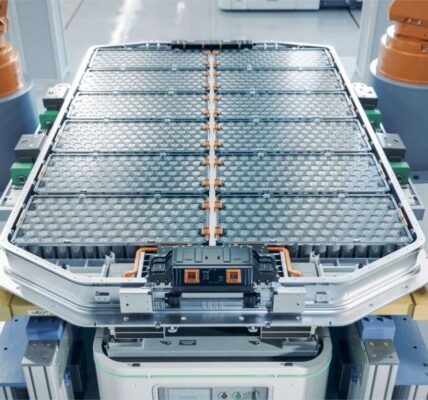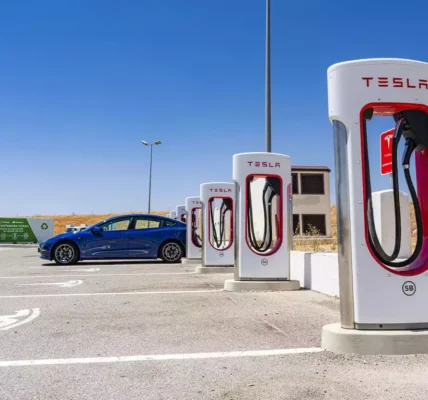EU negotiators are poised to agree the world’s most stringent standards for sustainable batteries on Friday in a bid to spur local cell production — but at the same time generous U.S. subsidies threaten to suck investments out of the Continent.
The new U.S. Inflation Reduction Act lavishes public cash on battery producers setting up in North America, which complicates the EU’s effort to encourage battery production at home in Europe, something that’s meant to be driven by the Batteries Regulation.
That rulebook is meant to ensure cells placed on the EU market are safe and sustainable, and will set requirements ranging from how batteries’ carbon footprint must be declared and how much recycled material they have to contain to collection targets for waste batteries and due diligence rules. The legislation will apply to both locally made and imported batteries, with the goal being to keep more of the production chain inside Europe and shift production from China, which dominates the global market for lithium-ion cells.
The EU’s new rules will be “an important package to make sustainability Europe’s batteries differentiator,” said Chris Heron, spokesperson for lobby group Eurometaux.
But greener EU standards will also drive up costs, so the industry is calling for a boost in subsidies from Brussels.
“We now need a bigger carrot for bringing new supply chain investments to Europe instead of the U.S. or China. One won’t work without the other,” Heron said.
Europe’s €20 billion Battery Alliance subsidy program launched in 2017, and is seeing some early results in battery makers opening factories on the Continent. However, the $369 billion IRA opens a firehose of U.S. cash for companies along the battery supply chain that could hobble European plans.
The IRA pays a $7,500 tax credit for locally made electric vehicles, but there’s much more money for batteries. As of next year the U.S. government will cover up to $45 per kilowatt hour of the production costs of a battery, and also subsidize 10 percent of the cost of battery parts and offer similar support for raw materials. Those subsidies will keep flowing through the early 2030s, offering battery-builders long-term certainty.
That will help producers source capital and get their cell costs below $100 per kilowatt hour, the point at which experts say battery cars become price-competitive with combustion engine models.
“The incentives for manufacturing investments are the game changer,” one auto executive said of the IRA’s provisions.
The U.S. EV subsidies have grabbed European attention, with top politicians demanding a rethink from the White House. But the battery subsidies are a bigger problem for Europe than the car cash.
Though the IRA policy is aimed at driving up sales of EVs, few clean cars are exported from Europe to the U.S. According to data compiled by consultancy IHS Markit, some 54,020 EVs were shipped west over the Atlantic in 2021, a tiny fraction of the 2.3 million such vehicles sold in Europe last year.
“We need to worry much more about the production credits than the consumer credits,” said William Todts, executive director of green NGO Transport & Environment. “Some people dismiss this, but with that level of subsidy and differences in energy prices there’s a real risk of production happening outside of Europe.”
Although the White House is under EU pressure to tweak the IRA, Internal Market Commissioner Thierry Breton said at a POLITICO event this week there is no chance of substantial changes: “What’s done is done.”
There is also no way that the IRA’s subsidies will be extended to batteries made outside North America, Todts said. Rather than badger Washington to change the IRA, he wants the European Commission to boost its own subsidy game.
On the Continent, public support comes in the form of one-off dollops of public state aid painstakingly assessed and approved by the Commission’s competition watchdogs. That’s quite different from the sustained industrial support approved in the U.S.
On Friday, the EU is also set to agree to a revamped association agreement with Chile, according to the Chilean foreign ministry and several EU diplomats. This will help the bloc gain access to massive stocks of lithium located on Chile’s Atacama salt flats.
European battery makers are already looking across the Atlantic.
Sweden’s Northvolt was supposed to open a German battery plant in 2025 but those plans are now in flux, said Anders Thor, a Northvolt spokesperson.
“Our aim is still to execute on our plans … but the rising costs in Europe, and the massive support that [the] U.S. administration is currently offering, has made strategic expansion decisions more complex,” Thor said, adding that the company will make a call on its future investment targets next year.
Volkswagen’s battery unit PowerCo aims to firm up plans for a Canadian factory in the next few months to “primarily cover the demand of the North American market,” according to a company spokesperson.
It’s not out the question that U.S.-made batteries, potentially even produced by Northvolt or PowerCo, could one day arrive in Europe. The VW brand’s CEO Thomas Schäfer has already blasted the EU’s failure to respond to the IRA.
With spiralling inflation and a tight market for raw materials, battery factory-builders are having to reassess where to allocate scare resources.
“With the Inflation Reduction Act, the U.S. offers companies highly attractive incentives for investments in new plant and production,” Schäfer said. “In the EU, on the other hand, outdated and bureaucratic state aid rules are adhered to.”
The Batteries Regulation complicates their thinking. The rules “will mean a lot of adaptation from both domestic and foreign players in the EU value chain,” said Giorgio Corbetta, the EU affairs director of industry lobby Eurobat.








